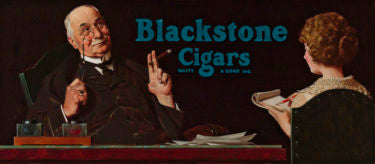
Oil's First Century by Norman Rockwell, advertisement for the American Petroleum Institute. Oil on canvas, circa 1959.
Alongside Norman Rockwell stands J.C. Leyendecker as one of the great legends of American illustration art. While both artists are best remembered today for their collective 643 Saturday Evening Post covers, they were also instrumental in the development of advertising as we know it today. Leyendecker’s “Arrow Collar Man” proved the age-old adage that sex sells, while his protégé, Rockwell, composed ads with the same wholesome charm as his iconic Post covers. Together, they elevated the art of advertising to new heights, and helped to cultivate the advertising industry into the revenue-producing behemoth it is today.
Leyendecker and the American Ideal

Leyendecker illustrated his first magazine cover for Collier’s in 1898, and just a year later he earned a coveted commission from the Saturday Evening Post. It would be the first of 322 covers he would illustrate for the iconic publication between 1899 and 1943. Yet, while his Post covers made him famous, it was his commercial commissions that supported his legendarily lavish lifestyle.
It was in 1905 that Leyendecker would earn that commission that changed his life. Cluett, Peabody & Company hired the rising young illustrator to compose a series of advertisements for the Arrow Brand of shirt collars. The result was Leyendecker’s “Arrow Collar Man,” a debonair, handsome figure that came to dominate the illustrator’s extensive oeuvre.
His subject was a cultural sensation; with his broad shoulders and strong chin, he represented an image of the debonair, ideal male that would subsist for more than 20 years. America was smitten, evidenced by the over 15,000 pieces of fan mail the fictional “Arrow Collar Man” received throughout the 20s.
The Birth of Modern Advertising
Leyendecker’s success stemmed from a revolutionary idea that seems so basic today. Rather than selling a shirt collar, the “Arrow Collar Man” sold the promise of a cosmopolitan lifestyle.
Before Leyendecker and the American illustrators entered the scene, the young but growing advertising industry relied primarily on text-laden ads that implored consumers to buy their product through lengthy narratives. Leyendecker’s “Arrow Collar Man” was instrumental in toppling this standard, proving that product could be sold through an image alone. Even today, this standard persists, with magazines full of highly visual ads promising another kind of life.
Advertising the American Dream
Leyendecker’s legacy is seen most readily in the work of his celebrated protégé, Norman Rockwell. Both artists' Post covers helped to define the American experience during both the tumultuous and the peaceful years of the 20th century. Rockwell's illustrations, like Leyendecker’s, promised something more. As filmmaker Steven Spielberg once said, “Rockwell painted the American dream – better than anyone.”

Instead of Leyendecker's idealized vision of masculinity, Rockwell rendered the details and nuances of ordinary people in everyday life. Young girls trying on a new pair of Mary Jane shoes, an old farmer shopping for a new car, friends enjoying a cigar on a hunt – these were the subjects of Rockwell’s ads. In his compositions, viewers saw idealized versions of their own daily lives. It proved a powerful advertising tool, so much so that by the end of his career, Leyendecker sometimes even took cues from his one-time student.
An American Legacy

Together, the ads of these great illustrators captured the essence of the American spirit at a compelling time in American history. Our 2015 exhibition America Illustrated: Six Decades of Saturday Evening Post Covers endeared all of us at M.S. Rau to the oft-overlooked mastery of these 20th century American artists. Yet, illustration art is finally having its day, particularly with the long-anticipated opening of the new Museum of Narrative Art in Los Angeles slated for 2021.
The art market is certainly taking notice – in 2013, Rockwell’s classic Post cover, Saying Grace, sold for a record $46 million at auction. The art of illustrated advertisement is on the rise as well, with Rockwell and Leyendecker standing at the top of this remarkable talent pool. To view our current collection of advertisements and other illustration art, click here.




